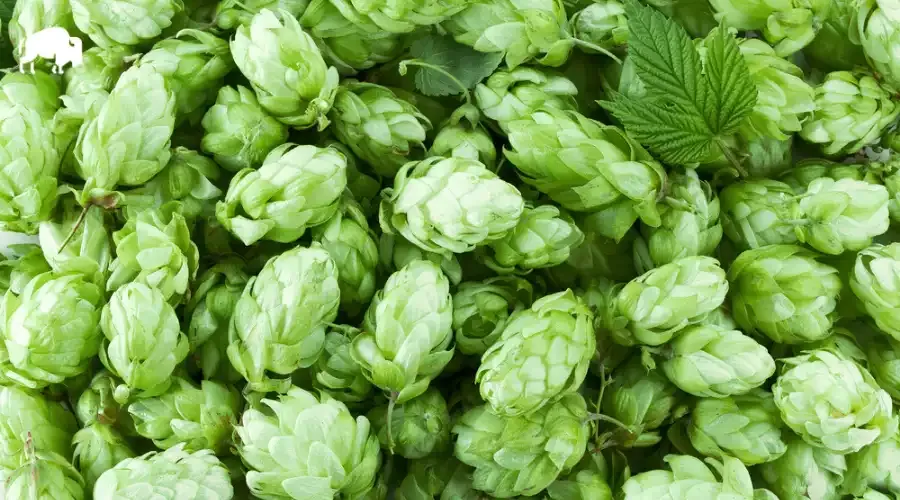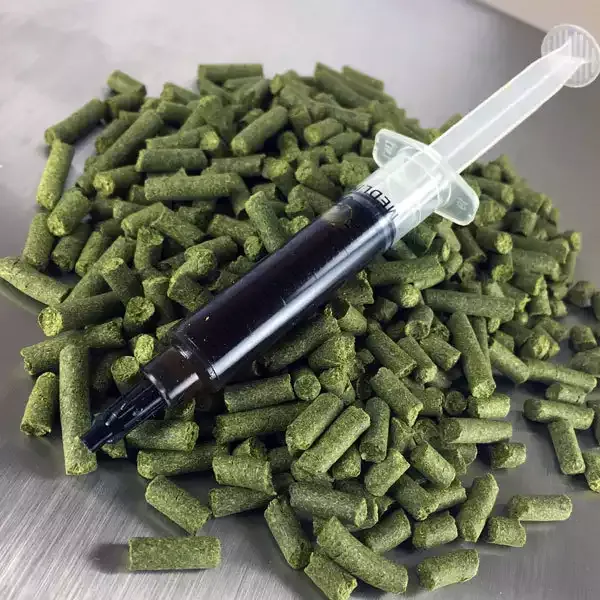
The harvest – finally reaping summer’s bounty. Nothing is more satisfying than picking a crop which has been carefully grown for months and experiencing its freshness. For brewers, this fleeting moment happens at the end of summer when hops are cultivated.
Fresh hops, also known as wet hops, are freshly picked, undried hop flowers used for providing bitterness and hoppy aromatics to beer. Brewing with fresh hops is done in a similar way to brewing with dried hops. They can be added at any point in the brewing process, from the start of the boil, whirlpool, to the dry hop. Since fresh hops are not dried, they weigh nearly five times as much as typical dried hops. For this reason, you have to use a lot more hops per batch to achieve similar levels of bitterness, flavor, and aroma.
We’ll tell you what you need to know about fresh hops and how you can use them in your beer this fall.
What are fresh hops?
Year round, brewers use dried hops in either whole leaf or pelletized form. Hops are dried to preserve their aromatic qualities and volatile oils. Dried hops can be stored for years with minimal degradation to their character as they only contain 8–10% moisture.
Fresh hops, on the other hand, need to be used immediately after the harvest. The hops are picked and used for brewing within 24 to 48 hours and have a moisture content of about 80%. Also known as wet hops, these freshly picked hops are sticky, wet, and extremely aromatic. Degradation occurs rapidly. Browning and decomposition will quickly turn the fresh hop flower into a rotten, soggy mess.
When you get your fresh hops, use them as quickly as possible. If you need to wait a day, store them in a sealed container in your refrigerator.
Because the hops are fresh, the hop oils are completely intact. Although dried hops preserve hop oils for long term, the drying process itself causes the most volatile oils to dissipate. Using wet hops you get all the resinous goodness in its purest form.
Fresh hops impart unique hop flavors to beer compared to dried hops. You still can expect the typical varietal specific flavors, whether that’s citrus, floral, or tropical fruit. But fresh hops also contribute a delightful grassiness. Chlorophyll flavors, like freshly cut grass, spiciness, and tobacco, are all part of the wet hop experience.
Where to get fresh hops?
Hop farms
Fresh hops are picked to be brewed within a day. Because of this, to get your hands on fresh hops, you need to be near a hop growing region during harvest season. Hops are harvested in the late summer to early fall, depending on the growing region.
There are hop farms all around the world, but depending on the region’s climate, you might have limited options in terms of the varietal.
Hop farms, such as Crosby Hops in Oregon, sell fresh hops by the pound which are available for pick up or express delivery. Search on Google for your nearest hop farm and give them a call to see if you can score some delicious, fresh hops.
Grow your own
Of course, if you have your own hop plants, you have a direct source to amazing fresh hops. When your hops are ready to pick, plan a brew day the day after your harvest. You’ll be able to experience the fruits of your labor in all their fresh and herbal glory.
The Original Craft Beer Club searches out exceptional craft beers from around the country and then delivers the monthly beer club selections direct-to-your door.
How should I use fresh hops?
Since fresh hops have not been put through hop oil analysis, the exact oil content of fresh hops is not known. The characteristics of hops change year to year, and crop to crop. Alpha acids used for bitterness calculations must be estimated based on expected values for the hop type.
Fresh hops have not yet been dried – that means water makes up most of their weight. Compared to a dried hop, a wet hop will weigh about 5 times more. That means that if you would normally use 1 ounce of a dried hop to bitter, you’ll need 5 ounces of wet hops to achieve the same bitterness or aromatics.
Fresh hops can be used at any point in the brewing process. Mash, boil, whirlpool, or dry hop – fresh hops are quite versatile. That being said, it’s recommended that you use dried hops early in the boil to impart bitterness. Not only will you be able to more accurately predict the bitterness, you’ll save your wet hops for the end of the boil. Doing this will get you more flavor and aroma out of the wet hops.
Beer styles
Not all beer styles are suitable for using fresh hops. Styles with limited hop character, like helles, for instance, will not benefit from the use of wet hops. In fact, most subtle beer styles may be overwhelmed with the chlorophyll and vegetal-like flavors brought on by fresh hops.
Hoppy English styles, like IPA, bitter, mild, and pale ale make great candidates to showcase fresh hops. American IPA, amber ales, and brown ales are also nice beer styles to try.
As mentioned, beers made with fresh hops will have a grassy or green-like flavor. For wet-hopped beers, this is not a defect but rather a consequence of brewing with fresh hops. Embrace this fresh character and enjoy the pungent and resinous punch of wet hops.
Fresh Hop Tips
- Consider bittering your homebrew with a neutral dried hop with known alpha acid. Not only will you get a more predictable bitterness, you’ll save all of the wet hops for later flavor additions.
- Depending on where you live, the hops available to you will be limited. If you live in the Pacific NorthWest, maybe you’ll score some fresh Citra or Mosaic. If you’re from a colder climate, you might find Goldings or Cascade. Whatever hops you get, design your beer recipe to suit the hops.
- Drink wet hopped beers fresh for the most flavorful experience.
- Use wet hops in moderation. Extremely hoppy styles like New England IPA (NEIPA) are probably not the best to use with fresh hops – you’ll end up with an overly vegetal tasting beer.
- Because you need to use a lot of fresh hops per brew, they will absorb a lot of wort. It helps to use a large mesh bag, like a brew in the bag style polyester bag, when you add fresh hops. Remove the bag and lightly squeeze out the wort at the end of the boil.
- Dry hopping with fresh hops is entirely possible, but there is a potential to contaminate your beer. Unlike dried hops, bacteria can live on fresh hops as there may be small insects still inside the fresh hop flower. If this worries you, add all of your fresh hops at the whirlpool stage and let them steep for 45 minutes.
Advanced Hopping Video Course
If you want to learn how to make great hoppy beers, check out this Craft Beer & Brewing video course:
Chris Tropeano, founder of Resident Culture Brewing and former brewer at Russian River, covers all of the practical knowledge you need to brew better hoppy beers.
It’s free for the first 30 days giving you access to over 60 homebrewing courses from the best brewers in the business.
Final Thoughts
Brewing with fresh hops is a once-a-year experience that showcases the summer’s bounty. Floral, grassy, and earthy, wet hops impart a unique character to beer that every brewer should try. Gaining insight into beer’s raw materials is invaluable to grow your brewing knowledge and experience. That direct connection with the hop, most brewers’ favorite flower, makes for an exciting and delicious brew day.
Frequently Asked Questions
Are fresh hops the same as whole leaf hops?
Whole leaf hops are often confused with fresh hops. Whole leaf refers to dried hops that have not been pelletized. They maintain the classic flower hop shape. These hops have been dried and are suitable for long term storage.
Fresh hops, being freshly picked, are wet to the touch and weigh much more than whole leaf hops. They are not interchangeable, neither in name or usage.
Can I brew with wild hops?
Ever come across hops growing in the wild? You might be struck with a large whiff of lupulin gold while out for a walk or hike. These are called wild hops, and they’re perfectly suitable for use in brewing.
The tricky part is knowing what type of hops they are and how you should use them. There is no way to know the type, oil concentrations, or best use. Your best bet is to brew up a basic pale ale with the hop. Use a known dried hop for bittering, and use your foraged hops at the end of the boil and whirlpool. Expect the unexpected, but you’ll surely craft a nice brew.



